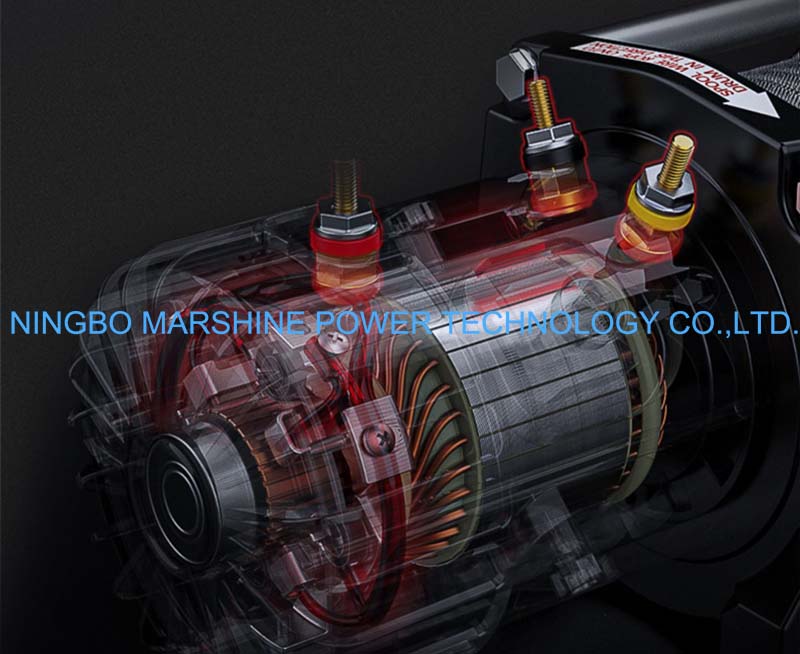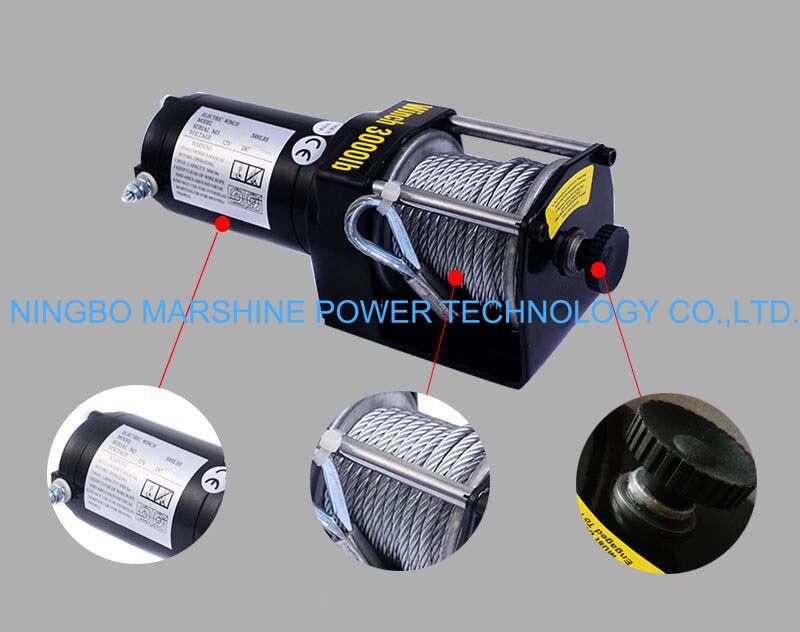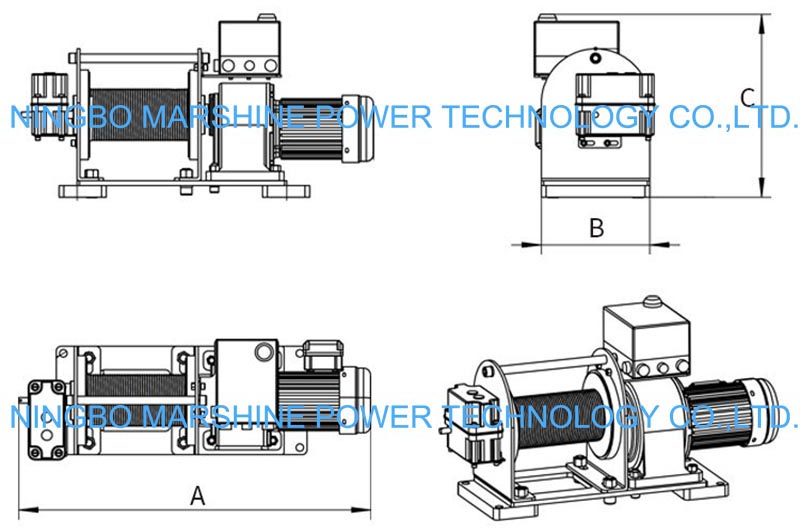MARSHINE is a Chinese electric power tools manufacturing company already passed the certification of quality system GB/T19001-2008 and consistently provides first-class products and services. And for the question, the answer is indeed. Shortening a MARSHINE cable puller winch directly boosts its pulling power and efficiency. It reduces cable resistance and improves mechanical advantage. This optimization makes operations faster, more economical, and less strenuous. Users achieve superior performance. This approach aligns with the demands of modern power grid construction and operation.

When you shorten the cable on your MARSHINE cable puller winch, you can boost its pulling power directly. This isn't just a small tweak, it fundamentally changes how the winch operates.
A shorter cable means less material working against your winch power, this can directly translates into more available power for the actual loads.
Imagine pulling a very long rope versus a short one. The longer rope itself has significant weight. Your cable puller winch has to overcome this weight before it even starts moving the intended load. With a shorter cable, the winch expends less energy just moving its own line. This leaves more of its motor's power to apply directly to the task at hand. It's like shedding unnecessary weight from a race car; it simply performs better.
Cables, especially when spooled, create friction within themselves. As a cable winds and unwinds, individual strands rub against each other. A longer cable means more of these internal rubbing points, generating more friction. This friction acts as a resistance, consuming some of the winch's power. By shortening the cable, you reduce the total length where this internal friction can occur. This allows more of the winch's mechanical energy to transfer efficiently to the load, rather than being lost to internal resistance.
The way cable spools onto the drum significantly affects pulling power. A winch achieves its maximum pull rating with only one layer of cable on the drum. Each additional layer of cable can cause a 12-15% loss of pulling power. For example, if you have four or five layers of cable wound on the drum, you could lose up to 50% of the maximum pulling power. To get the most out of your MARSHINE cable puller winch, it's always best to unroll more line. This gets you closer to that powerful first layer. For the toughest pulls, aim to get down to the last layer, always making sure at least five wraps of wire rope or a full layer of synthetic rope remain for safety.

A shorter cable also enhances the mechanical advantage your winch can achieve. This means the winch applies force more effectively.
When a cable is shorter, it tends to spool more evenly and closer to the drum's core. This provides better leverage for the winch motor. The motor can apply its torque more directly and efficiently to the cable. Think of it like using a shorter lever to lift something; if the pivot point is closer to the load, you get more direct power. This optimized force application means less wasted energy and more direct pulling strength.
All cables stretch a little under heavy load. A longer cable stretches more than a shorter one under the same force. This stretch absorbs some of the winch's initial pulling energy. With a shorter cable, there is simply less material to stretch. This means the winch's power translates more immediately into movement of the load, rather than being absorbed by cable elongation. You get a more responsive and direct pull.
The mechanical advantage of a winch is highest when the cable is on the innermost layer of the drum. As more layers build up, the effective diameter of the drum increases. This reduces the mechanical advantage, similar to how a larger gear requires more turns to achieve the same output. By using a shorter cable, you inherently keep more of your operations closer to that optimal, innermost layer. This maximizes the mechanical advantage the winch can provide, giving you more effective pulling power for every revolution of the drum.
Beyond just mechanical advantage, a shorter cable significantly reduces energy waste.
When a cable stretches, it undergoes elastic deformation. This means it temporarily changes shape. The energy used to cause this deformation is stored within the cable. While some of this energy might return as the cable contracts, a significant portion dissipates as heat or is simply lost. A shorter cable experiences less overall elastic deformation. This minimizes the amount of energy wasted in stretching the cable itself.
With less energy lost to stretching and internal friction, more of the winch's power directly transfers to the load. This means the motor's effort goes where it's needed most: moving the object. This direct energy transfer makes the pulling operation more efficient and powerful. You get more "bang for your buck" from every watt of power your winch consumes.
Consider the energy dynamics. A longer cable acts like a spring, absorbing and releasing energy. This absorption and release cycle is not 100% efficient. Each cycle loses a small amount of energy. By shortening the cable, you reduce the "spring" effect. This minimizes the energy lost in the cable's elastic properties. The result is a more direct and efficient transfer of power from the winch motor to the load, leading to a noticeable increase in effective pulling power and reduced energy waste.

Shortening the cable on a MARSHINE winch does more than just boost power. It also makes the entire operation much more efficient. This means less energy used, faster work, and longer-lasting equipment. These benefits are crucial for modern power grid projects.
An efficient winch uses less power to do the same job. A shorter cable helps achieve this goal.
When a winch pulls a load, its motor works hard. A longer cable adds weight and friction. This forces the motor to work even harder. By shortening the cable, the motor faces less resistance. It does not have to overcome as much internal friction or cable weight. This reduces the strain on the motor. A less strained motor runs cooler and more smoothly. It also uses less energy to achieve the desired pulling force.
Every pull operation consumes energy. When the motor works less, it uses less electricity or fuel. This translates directly into energy savings for each task. Over many pulls, these small savings add up significantly. For large-scale projects, this can mean substantial reductions in operational costs. It also contributes to a more sustainable work practice.
Imagine comparing two identical MARSHINE winches. One uses a standard long cable, and the other uses a shortened cable. Data would clearly show the difference. The winch with the shorter cable would consistently record lower power consumption readings for similar loads and distances. This data proves the efficiency gains. It highlights how optimizing cable length directly impacts energy usage.
Efficiency also means getting the job done quickly. A shorter cable helps winches operate at higher speeds.
A shorter cable reduces energy loss from friction and stretch. More of the winch's power goes directly into moving the load. This "effective power" allows the winch to accelerate the load faster. It also maintains higher speeds throughout the pull. The motor does not waste energy fighting cable resistance. Instead, it applies that energy to the actual pulling motion.
Faster pull speeds directly lead to quicker job completion times. If each pull takes less time, the entire project finishes sooner. This is a major advantage in time-sensitive construction or maintenance work. It allows crews to move on to the next task more rapidly. This boosts overall productivity for the team.
Field tests would demonstrate these speed improvements. A winch with a shorter cable would consistently complete pulls in less time than one with a longer cable, assuming identical loads and conditions. This data provides clear evidence of enhanced operational speed. It shows how a simple cable adjustment can significantly impact project timelines.
Less strain and more efficient operation also mean less wear on the winch itself. This extends the life of the equipment.
When a motor operates under less strain, it generates less heat. Excessive heat is a primary cause of motor degradation. By reducing the workload, a shorter cable helps the motor run cooler. This significantly extends its operational lifespan. It means fewer repairs and replacements for this critical component.
Optimizing cable length directly reduces stress on drivetrain components. It prevents damage to the winch. If the rope is too long, it can overload one side of the winch drum during angled pulls. This causes the rope to contact the winch's tie-bars. This contact can damage the rope and ultimately destroy the winch. This shows a direct link between proper cable length and the longevity of the drivetrain components. A shorter, properly managed cable ensures the entire drivetrain, including gears and shafts, operates within its optimal parameters. This reduces the likelihood of premature failure.
Long-term maintenance records would support these claims. Winches consistently operated with optimized, shorter cables would show fewer component failures. They would also require less frequent servicing compared to those using excessively long cables. This data confirms that proper cable management contributes to the overall durability and reliability of the equipment.
Optimizing your cable length offers many benefits. However, careful planning and adherence to safety standards are crucial. Users must consider practical aspects to maximize power and efficiency safely.
Finding the right cable length is a balance. You need enough reach but not too much excess.
First, determine the longest distance your operations typically require. Consider the farthest point a load needs to travel. Always add a buffer for unexpected situations or varied job sites. This ensures you never come up short.
The National Fire Protection Association (NFPA) 1901, Standard on Automotive Fire Apparatus, suggests a minimum of 75 feet of rope for each winch.
Measure your maximum required pull distance. Then, add the necessary safety wraps for the winch drum. Most manufacturers recommend at least five to seven wraps remaining on the drum at all times. This total gives you the ideal shortened length. It provides maximum power without compromising safety.
Consider a utility crew. They often pull short sections of conduit. Using a MARSHINE winch with a precisely shortened cable significantly reduces their setup time. It also boosts the effective pulling power for each task. This leads to faster project completion.
Safety remains paramount when adjusting cable length. Proper procedures protect both operators and equipment.
Always ensure the cable's end is securely terminated. Use appropriate thimbles and swages or splices. Follow the manufacturer's guidelines for attachment. A weak termination can lead to catastrophic failure under load.
A shorter cable increases effective power. However, never exceed the rated capacity of your MARSHINE winch or the cable itself. Understand the working load limit (WLL) of your cable. This prevents overloading and potential damage.
Do not make the cable too short. An insufficient length might not allow enough safety wraps on the drum. This could cause the cable to detach under load. Always ensure at least five wraps remain on the drum for safe operation.
Technology continues to advance rapidly. These innovations will further enhance the benefits of optimized cable lengths.
The future of winching includes smart systems. These systems use automation and IoT capabilities. They optimize efficiency, safety, and remote monitoring. AI-driven predictive maintenance reduces downtime.
New cable materials offer higher strength-to-weight ratios. They allow for smaller cable diameters with the same strength. This further enhances the benefits of shorter, lighter cables.
Sensors will monitor cable condition in real-time. AI analyzes this data. It predicts maintenance needs before failures occur. This prevents unexpected downtime and extends cable life.
MARSHINE continually develops advanced, safe, and easy-to-handle products. The company passed the certification of quality system GB/T19001-2008. We consistently engage in power grid construction and operation. We provide first-class products and services.
Shortening your MARSHINE cable puller winch directly boosts its pulling power and efficiency. It achieves this by:
This leads to faster, more economical, and less strenuous operations. These benefits align perfectly with modern power grid construction and operation demands. Users understand these principles. They can optimize their MARSHINE equipment for superior performance in 2025 and beyond.

A shorter cable reduces its own weight and internal friction. This means the MARSHINE winch motor uses more power to pull the load, rather than waste the energy on the cable itself.
Less cable means less energy loss from stretch and friction. This allows the MARSHINE winch to pull cables faster while reducing the power cost, this makes operations more economical.
Yes, it can be dangerous. Please always leave at least five wraps of cable on the MARSHINE winch drum. Too little cable can cause it to detach under the load.
The optimal length meets your maximum reach needs, and it also includes enough safety wraps on the drum. Please measure your longest pull, and then add the required safety wraps. This can gives you the ideal length for your MARSHINE winch.
Absolutely. A shorter cable can reduces the motor strain and stress on the drivetrain. This is able to helps the MARSHINE winch components last longer, which means less maintenance and a longer lifespan for the equipment.
Yes, it will. A shorter cable will reduces the energy loss. More effective power goes to the load. This allows the MARSHINE winch to achieve faster pull speeds and so that to helps the workers completing the jobs quicker.
Please ensure the secure cable termination, and always adhere to the load ratings of your MARSHINE winch and cables. To avoid the over-shortening, please make sure at least five wraps remain on the drum for the safety factor.
